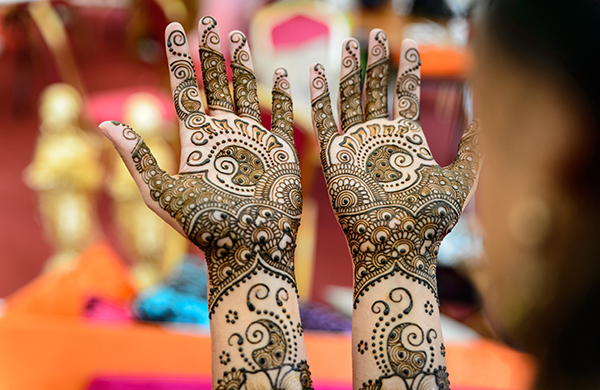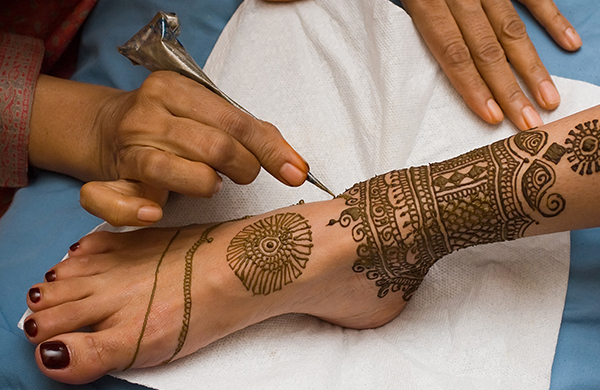
Growing up, I wore henna on my hands any chance I could get. I loved everything about it: the scent, the intricate detailing, and, most especially, how it made me feel so connected to my Pakistani culture. At the time, though, there was potential for pitfalls.
Once, in the third grade, I vividly remember going to school with henna-stained hands only for my teacher to go berserk. She started grilling me in front of the whole class about what was on my hands, asking questions like “Is that a disease or something?” or my personal favorite, “Did your parents actually let you get a tattoo?!”
I was embarrassed to be put on the spot, but I didn’t mind explaining what henna was. After all, I was used to most people’s unfamiliarity with it, even though henna has been used for body art around the world since antiquity. These days, growing awareness of henna means that classroom scene might less likely to happen. Henna has increasingly become a mainstream trend in the West; both Coachella denizens and celebrities like Beyoncé have used it as a fashion accessory.
Most people, however, are still vague on the specifics. Below, learn more about the traditional importance of henna and how the temporary tattoos have expanded beyond their original cultural borders.
What is henna, exactly?
Leaves from the henna plant are dried, crushed up, and then mixed with water and essential oils. The blend creates a deep olive-colored paste that, when applied to the skin, eventually produces a reddish-brown stain thanks to its natural dyes. Henna artists use special tools to create intricate designs with the paste. The result is similar to a tattoo, except that it’s semi-permanent and completely painless.

Traditionally, what is henna for?
Henna has been used for centuries to adorn hands and feet—primarily those of women. Most common in South Asia, the Middle East, and North Africa, henna is applied in honor of religious holidays and weddings. (Westerners are probably most familiar with the mehndi designs on Indian and Pakistani brides.)
“It's important to distinguish that its use really isn't ‘religious,’” said artist Darcy Vasudev, the owner of Henna Lounge in San Francisco, which provides bridal mehndi along with other nontraditional uses, such as the so-called hipster henna.
“It's cosmetic—think of it as a piece of jewelry, nail polish, a special garment.”
“However,” she said, “the symbols used in henna (especially in Muslim countries) often contain motifs thought to ward off the evil eye. In Morocco in particular, applying henna is thought to appease the Djinn (genies/spirits who cause mischief), and it's common for women to apply henna as a sort of good-luck ritual to avoid becoming ill.”
What about its nontraditional uses?
Although it’s historically applied to the extremities, henna can be displayed virtually anywhere on the body. And nowadays it’s used for a wide range of contemporary purposes. At music festivals and other events, attendees often get less elaborate versions of the traditional designs. Alternatively, people might use henna as a temporary tattoo of any design or as a way to try out a tattoo they might like to ink permanently in the future.
On the heartwarming end of the spectrum, it’s a growing trend for pregnant women to get their bellies decorated with henna, often prior to a maternity photo shoot or a baby shower. Some patients undergoing chemotherapy adorn their newly bald heads with henna crowns. (Just a tip: people in both groups should consult with their doctor and henna artist to make sure the formula used is safe. All-natural is the way to go.)

“The intent is to bring good luck and protection and fertility, to aid in healing” in a symbolic way, Vasudev said. “My clients are still asking for the traditional protection and luck associated with henna.”
Due to its magnificent staining power, henna can also be used as a natural alternative to synthetic hair dyes or nail stains. In fact, it’s been used to dye hair for millennia. Historically hair was dyed red or orange, but nowadays henna for hair—sometimes mixed with other natural dyes—can achieve colors ranging from light red to black.
How does the tattooing process work?

The application process is quite relaxing and almost therapeutic. Usually performed freehand, it takes anywhere from minutes for a simple motif to hours for a more intricate pattern. When the paste dries, some choose to apply a mixture of lemon juice and sugar on top to seal in the dye and help intensify the color of the stain.
Although that step is optional, the wait is not: the longer the paste is left on the skin, the darker the stain will be. At the very least, artists recommend keeping it on for four hours; leaving the paste on overnight is encouraged. Once the dried paste flakes off or is removed, the stain gradually darkens and reaches its peak intensity within the first 48 hours. Depending on your skin tone, it can range from a bright shade of orange to a deep burgundy hue.
How long does henna last?
Henna tattoos slowly fade over time due to natural exfoliation of the skin. They typically last anywhere from one to three weeks—allowing you to enjoy beautiful body art without any of the long-term commitment. To keep the tattoo looking fresh and vibrant for as long as possible, apply a light coat of olive oil, beeswax, or henna balm before bathing or swimming.
So how can I get henna for myself?
Lots of families apply the henna themselves or hire professional artists to come to their homes ahead of weddings and religious festivals. But many of these services can also be found at studios that perform eyebrow threading; both arts originated in South Asia and the Middle East.
When it comes to the henna’s placement, patterns, and symbolism, the options are basically endless for traditional and modern styles alike. I'm just happy its increasing popularity means I don’t have to explain what's on my hands anymore.
 |
Our beauty editor Anam Ather is a self-proclaimed former prom princess turned blogger who compiles all of her beauty and fashion musings at The Style Menu. |
More to read on more shades of body ink:
Tattoo artists (and wearers) give advice on what to expect and how to tell if you’re ready for ink.
It may be for you. Or maybe not. We got the skinny from a real-life permanent-makeup artist.